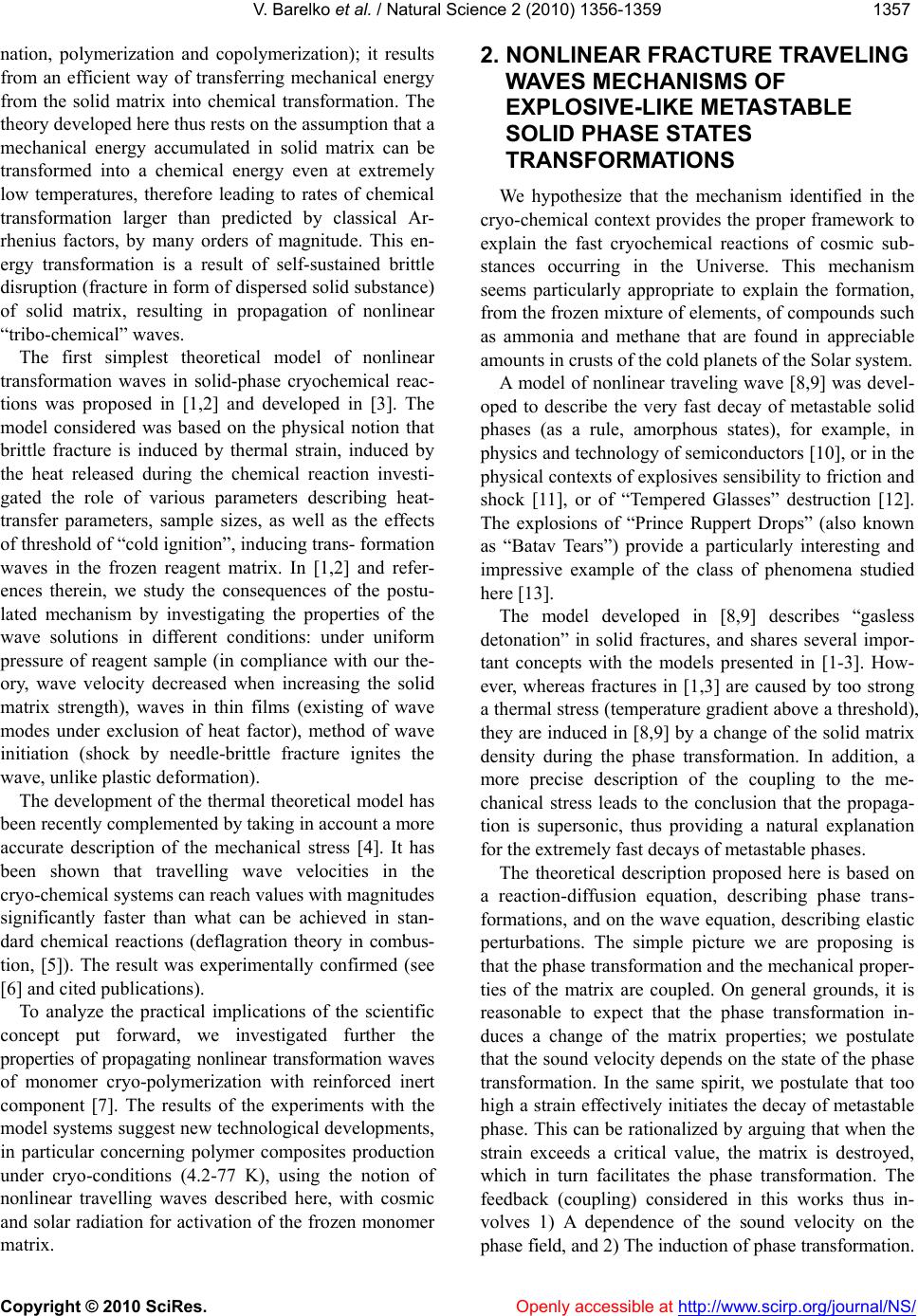
V. Barelko et al. / Natural Science 2 (2010) 1356-1359
Copyright © 2010 SciRes. Openly accessible at http://www.scirp.org/journal/NS/
135
1357
nation, polymerization and copolymerization); it results
from an efficient way of transferring mechanical energy
from the solid matrix into chemical transformation. The
theory developed here thus rests on the assumption that a
mechanical energy accumulated in solid matrix can be
transformed into a chemical energy even at extremely
low temperatures, therefore leading to rates of chemical
transformation larger than predicted by classical Ar-
rhenius factors, by many orders of magnitude. This en-
ergy transformation is a result of self-sustained brittle
disruption (fracture in form of dispersed solid substance)
of solid matrix, resulting in propagation of nonlinear
“tribo-chemical” waves.
The first simplest theoretical model of nonlinear
transformation waves in solid-phase cryochemical reac-
tions was proposed in [1,2] and developed in [3]. The
model considered was based on the physical notion that
brittle fracture is induced by thermal strain, induced by
the heat released during the chemical reaction investi-
gated the role of various parameters describing heat-
transfer parameters, sample sizes, as well as the effects
of threshold of “cold ignition”, inducing trans- formation
waves in the frozen reagent matrix. In [1,2] and refer-
ences therein, we study the consequences of the postu-
lated mechanism by investigating the properties of the
wave solutions in different conditions: under uniform
pressure of reagent sample (in compliance with our the-
ory, wave velocity decreased when increasing the solid
matrix strength), waves in thin films (existing of wave
modes under exclusion of heat factor), method of wave
initiation (shock by needle-brittle fracture ignites the
wave, unlike plastic deformation).
The development of the thermal theoretical model has
been recently complemented by taking in account a more
accurate description of the mechanical stress [4]. It has
been shown that travelling wave velocities in the
cryo-chemical systems can reach values with magnitudes
significantly faster than what can be achieved in stan-
dard chemical reactions (deflagration theory in combus-
tion, [5]). The result was experimentally confirmed (see
[6] and cited publications).
To analyze the practical implications of the scientific
concept put forward, we investigated further the
properties of propagating nonlinear transformation waves
of monomer cryo-polymerization with reinforced inert
component [7]. The results of the experiments with the
model systems suggest new technological developments,
in particular concerning polymer composites production
under cryo-conditions (4.2-77 K), using the notion of
nonlinear travelling waves described here, with cosmic
and solar radiation for activation of the frozen monomer
matrix.
2. NONLINEAR FRACTURE TRAVELING
WAVES MECHANISMS OF
EXPLOSIVE-LIKE METASTABLE
SOLID PHASE STATES
TRANSFORMATIONS
We hypothesize that the mechanism identified in the
cryo-chemical context provides the proper framework to
explain the fast cryochemical reactions of cosmic sub-
stances occurring in the Universe. This mechanism
seems particularly appropriate to explain the formation,
from the frozen mixture of elements, of compounds such
as ammonia and methane that are found in appreciable
amounts in crusts of the cold planets of the Solar system.
A model of nonlinear traveling wave [8,9] was devel-
oped to describe the very fast decay of metastable solid
phases (as a rule, amorphous states), for example, in
physics and technology of semiconductors [10], or in the
physical contexts of explosives sensibility to friction and
shock [11], or of “Tempered Glasses” destruction [12].
The explosions of “Prince Ruppert Drops” (also known
as “Batav Tears”) provide a particularly interesting and
impressive example of the class of phenomena studied
here [13].
The model developed in [8,9] describes “gasless
detonation” in solid fractures, and shares several impor-
tant concepts with the models presented in [1-3]. How-
ever, whereas fractures in [1,3] are caused by too strong
a thermal stress (temperature gradient above a threshold),
they are induced in [8,9] by a change of the solid matrix
density during the phase transformation. In addition, a
more precise description of the coupling to the me-
chanical stress leads to the conclusion that the propaga-
tion is supersonic, thus providing a natural explanation
for the extremely fast decays of metastable phases.
The theoretical description proposed here is based on
a reaction-diffusion equation, describing phase trans-
formations, and on the wave equation, describing elastic
perturbations. The simple picture we are proposing is
that the phase transformation and the mechanical proper-
ties of the matrix are coupled. On general grounds, it is
reasonable to expect that the phase transformation in-
duces a change of the matrix properties; we postulate
that the sound velocity depends on the state of the phase
transformation. In the same spirit, we postulate that too
high a strain effectively initiates the decay of metastable
phase. This can be rationalized by arguing that when the
strain exceeds a critical value, the matrix is destroyed,
which in turn facilitates the phase transformation. The
feedback (coupling) considered in this works thus in-
volves 1) A dependence of the sound velocity on the
phase field, and 2) The induction of phase transformation.